Introduction
Do you struggle to wake up feeling refreshed and ready to conquer the day?
Starting your morning with a simple stretching routine can be the secret weapon you’ve been missing. Imagine waking up, shaking off the grogginess, and setting a positive tone for the day ahead—all in just a few minutes. Morning stretches aren’t just for yogis or fitness enthusiasts; they’re for anyone who wants to feel more energetic, focused, and ready to tackle life’s daily demands.Stretching in the morning helps improve blood flow, reduce stiffness, and increase flexibility. After a long night of being relatively stationary, your muscles can feel tight, and your joints may lack mobility. Incorporating morning stretches into your routine can help awaken your body and mind, preparing you for whatever lies ahead.In this blog, we’ll walk you through five easy and effective stretches that anyone can do. Whether you’re a beginner or someone with more experience, these stretches are designed to energize your body, improve your posture, and leave you feeling refreshed—all within 10 minutes. Let’s dive in!
1. Cat-Cow Stretch
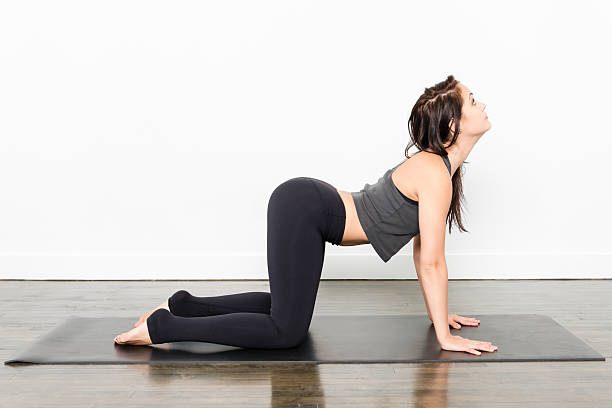
Description
The Cat-Cow stretch is a gentle, yoga-inspired movement that focuses on spinal flexibility and mobility. This flow isn’t just about stretching—it’s about connecting movement with breath. As you alternate between the Cat (rounding your spine) and Cow (arching your back) poses, you’ll feel a wave of relaxation while gently waking up your body.This stretch is perfect for anyone who spends long hours sitting or waking up with a stiff back. It’s a great way to loosen up your spine and improve your posture.
How to Do It
- Start by getting on your hands and knees in a tabletop position. Ensure your wrists are directly under your shoulders and your knees are aligned with your hips.
- Inhale deeply and drop your belly towards the floor. Lift your head and tailbone towards the sky, forming a gentle arch in your back—this is the Cow pose.
- Exhale slowly while rounding your spine upwards, like a scared cat. Tuck your chin to your chest and pull your belly button toward your spine—this is the Cat pose.
- Repeat this flow for 5–10 breaths, moving slowly and deliberately.
Benefits
- Relieves tension in the back and neck.
- Enhances spinal mobility and flexibility.
- Improves blood circulation, leaving you feeling energized.
Pro Tip: Synchronize your breath with each movement. Inhale as you move into Cow and exhale as you transition to Cat. This helps calm your mind and create a deeper sense of relaxation.
Join the 120-Day Transformation with Calofit – Start Now!
2. Standing Forward Fold
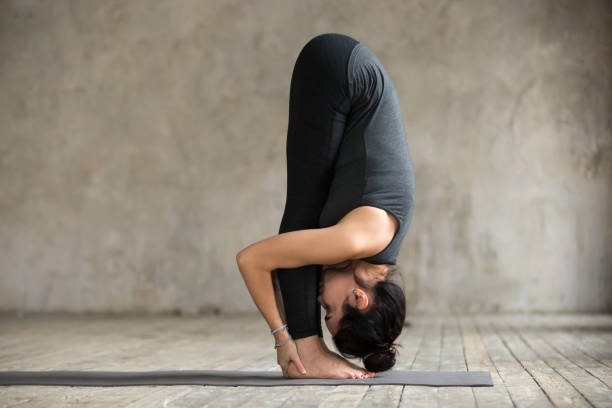
Description
The Standing Forward Fold is a classic stretch that targets your hamstrings, calves, and lower back. It’s a simple yet powerful pose that not only stretches your body but also helps calm your mind. This stretch is particularly effective if you wake up feeling tight in your legs or lower back.The beauty of this pose is its versatility. You can modify it based on your flexibility level—bend your knees slightly if your hamstrings feel tight, or deepen the stretch if you’re more advanced.
How to Do It
- Start by standing tall with your feet hip-width apart.
- Inhale and reach your arms up toward the ceiling, lengthening your spine.
- Exhale and slowly hinge at your hips, folding your upper body forward. Let your arms hang down toward the floor.
- Keep your knees slightly bent if needed to avoid straining your hamstrings or back.
- Hold the pose for 15–30 seconds while breathing deeply.
- Slowly roll back up to a standing position, vertebra by vertebra, to avoid dizziness.
Benefits
- Stretches the hamstrings, calves, and lower back.
- Stimulates blood flow to the brain, promoting mental clarity.
- Reduces stress and helps calm the nervous system.
Pro Tip: Let your head hang heavy and relax your neck completely. This will help relieve tension in the upper body and deepen the stretch in your back.
Join the 120-Day Transformation with Calofit – Start Now!
3. Side Body Stretch
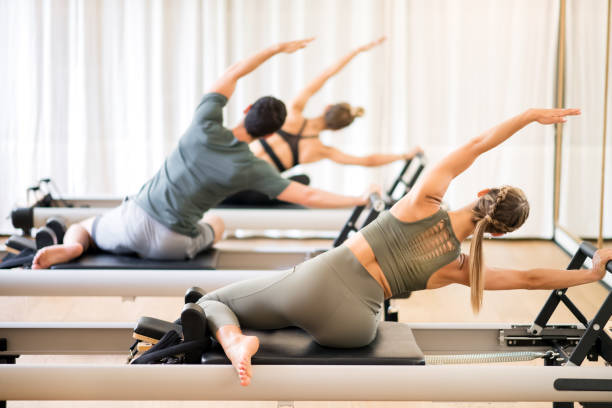
Description
The Side Body Stretch is an underrated yet highly effective movement. It targets the obliques, shoulders, and intercostal muscles (the muscles between your ribs), which often get neglected in traditional stretching routines. This stretch creates space in your torso, improves posture, and enhances breathing by opening up the chest and ribcage.Whether you’re seated at a desk for long periods or simply want to feel taller and more aligned, this stretch is a game-changer.
How to Do It
- Stand tall with your feet shoulder-width apart.
- Inhale and raise your right arm overhead, bending slightly to the left.
- Keep your left hand resting on your hip or extended down your side for support.
- Hold the stretch for 15–20 seconds, breathing deeply into your right side.
- Return to a neutral position and repeat on the opposite side.
Benefits
- Improves posture by elongating the side body.
- Relieves tension in the shoulders and obliques.
- Promotes better breathing by expanding the ribcage.
Pro Tip: To deepen the stretch, focus on reaching upwards before bending sideways. This will help lengthen your spine and avoid collapsing your torso.
4. Seated Spinal Twist
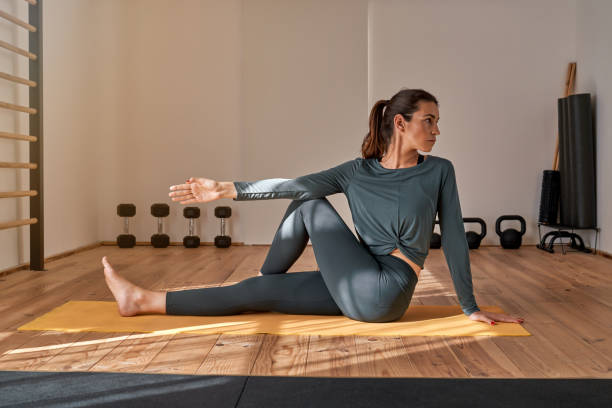
Description
The Seated Spinal Twist is a powerful stretch for your spine, shoulders, and neck. Twists are excellent for releasing tension in the back and improving overall spinal health. This stretch also aids digestion by gently massaging the abdominal organs, making it a great addition to your morning routine.Even if you’re not flexible, this pose can be easily modified to suit your body’s needs.
How to Do It
- Sit on the floor with your legs extended straight in front of you.
- Bend your right knee and place your right foot flat on the ground, crossing it over your left leg.
- Place your right hand behind you for support and your left elbow on the outside of your right knee.
- Inhale to lengthen your spine, and exhale as you twist to look over your right shoulder.
- Hold the pose for 15–30 seconds, then return to center and repeat on the other side.
Benefits
- Improves spinal flexibility and mobility.
- Relieves tension in the back and shoulders.
- Stimulates digestion and detoxification.
Pro Tip: Keep your spine straight throughout the twist. Imagine lifting upwards with your crown rather than slouching into the pose.
Join the 120-Day Transformation with Calofit – Start Now!
5. Downward Dog Stretch
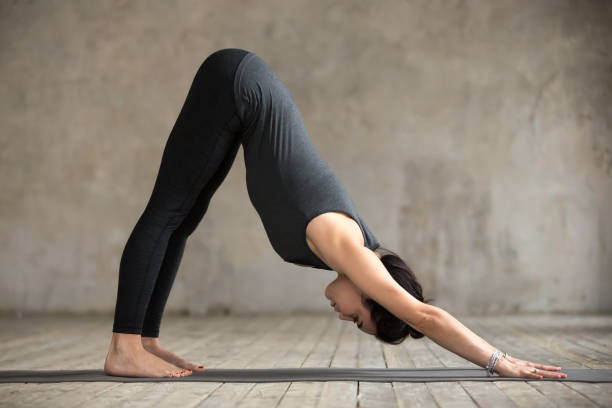
Description
Downward Dog is a full-body stretch that many people recognize from yoga. It works wonders for your back, shoulders, arms, and hamstrings while also strengthening your core. This pose is invigorating and will leave you feeling energized and ready to take on the day.It’s a great way to stretch out your entire body after a night’s rest, especially if you wake up feeling stiff.
How to Do It
- Start in a tabletop position with your hands under your shoulders and knees under your hips.
- Tuck your toes under and lift your hips towards the ceiling, forming an inverted V-shape.
- Keep your hands and feet firmly planted on the ground, with your fingers spread wide.
- If your hamstrings feel tight, keep your knees slightly bent.
- Hold the pose for 15–30 seconds, breathing deeply.
Benefits
- Stretches the back, shoulders, and hamstrings.
- Boosts circulation and energizes the body.
- Strengthens arms and core muscles.
Pro Tip: Focus on lengthening your spine rather than forcing your heels to touch the ground. Over time, your flexibility will improve naturally
Join the 120-Day Transformation with Calofit – Start Now!
Tips for a Successful Morning Stretch Routine
Incorporating stretching into your morning doesn’t have to be complicated. Here are a few tips to make it a consistent and enjoyable habit:
- Start Slow: Don’t push yourself too hard, especially if your body feels tight. Morning stretches should feel good, not painful.
- Listen to Your Body: Everyone’s flexibility levels are different. Modify the stretches to suit your needs.
- Pair Stretches with Breathing: Deep breathing enhances relaxation and helps you connect with your movements.
- Stay Consistent: Commit to doing these stretches every morning for at least a week. Consistency is key to seeing long-term benefits.
- Create a Relaxing Environment: Play calming music or light a candle to make your stretching routine even more enjoyable.
FAQs
1. How long should my morning stretch routine take?
A morning stretch routine can be as short as 5–10 minutes or as long as 20–30 minutes, depending on how much time you have. The five stretches in this blog can be completed in about 10 minutes, making them perfect for busy mornings.
2. Can I stretch if I feel stiff or sore?
Absolutely! Stretching is a great way to relieve stiffness and soreness. However, start gently and listen to your body. Avoid forcing movements that feel painful and modify poses if needed. Over time, consistent stretching can reduce stiffness altogether.
3. Do I need any equipment for these stretches?
No equipment is required! All of the stretches listed in this blog can be done on a yoga mat or any comfortable surface. If you want extra support, you can use a cushion, towel, or yoga block for some poses.
4. Can beginners do these stretches?
Yes! These stretches are beginner-friendly and suitable for people of all fitness levels. Modifications are provided for those who may need extra support or have limited flexibility.
5. What if I don’t feel flexible enough to do some of these stretches?
Flexibility is something you develop over time, and it’s perfectly normal to feel stiff, especially in the morning. The key is to start where you are and modify stretches as needed. For example, you can bend your knees during a Standing Forward Fold or keep your heels lifted in Downward Dog. Consistency will help improve your flexibility.
6. Should I stretch before or after eating breakfast?
It’s best to stretch before eating breakfast. Stretching on an empty stomach allows for better movement and reduces any discomfort caused by digestion. Afterward, enjoy a light, healthy breakfast to fuel your day.
7. Can I do these stretches at night instead of in the morning?
Yes! While these stretches are designed to energize your body in the morning, they can also be done at night to relax your muscles and wind down before bed. However, for the most energizing benefits, it’s ideal to do them in the morning.
8. How often should I do these stretches?
For the best results, aim to do these stretches every day as part of your morning routine. Consistency is key to improving flexibility, reducing stiffness, and experiencing long-term benefits. Even a few days a week can make a noticeable difference.
9. Are these stretches safe for people with back pain or injuries?
These stretches are generally gentle and safe, but if you have back pain, injuries, or any medical conditions, consult with a healthcare professional or physical therapist before starting any new stretching routine. Modify or skip poses that feel uncomfortable and avoid pushing your body too hard.
10. Can I combine these stretches with other morning exercises?
Absolutely! These stretches pair well with other forms of morning exercise, such as yoga, Pilates, or even light strength training. Stretching before or after a workout can help warm up or cool down your muscles, reducing the risk of injury.
11. What are the benefits of pairing these stretches with deep breathing?
Deep breathing enhances the effects of stretching by helping you relax, improving oxygen flow, and creating a mind-body connection. Breathing deeply during each stretch can also reduce stress, calm your nervous system, and make the poses feel more effective.
12. How can I stay consistent with my morning stretch routine?
- Start small: Commit to just 5–10 minutes a day at first, so it doesn’t feel overwhelming.
- Set a reminder: Use an alarm or calendar notification to remind yourself to stretch at the same time every morning.
- Make it enjoyable: Play calming music, stretch in a cozy corner, or pair it with something you love (like a hot cup of tea afterward).
- Track your progress: Keep a journal or note how you feel after each session to stay motivated.
- Involve others: Invite a friend or family member to join you for accountability and added fun!
13. Can these stretches improve my posture?
Yes! Many of these stretches, such as the Cat-Cow, Side Body Stretch, and Seated Spinal Twist, help elongate your spine, release tension in your back, and strengthen supporting muscles. Over time, regular stretching can improve your posture by making it easier to sit and stand upright.
14. What should I wear for stretching?
Wear comfortable, loose-fitting or stretchy clothing that allows you to move freely. Yoga pants, shorts, or sweatpants paired with a breathable top work well. Avoid anything tight or restrictive, as it may interfere with your range of motion.
15. Can I stretch if I’m pregnant?
Yes, but it’s important to be cautious and modify stretches to suit your body’s needs during pregnancy. For example, avoid deep twists or poses that put pressure on your abdomen. Consult with your doctor or a prenatal yoga instructor for safe and appropriate modifications.
16. Will stretching help with morning grogginess?
Absolutely! Stretching increases blood flow, warms up your muscles, and stimulates your nervous system, all of which help reduce grogginess and wake you up. Pairing stretching with deep breathing further enhances this effect by increasing oxygen flow to your brain.
17. Are there any risks to stretching in the morning?
Stretching in the morning is generally safe, but it’s important to:
- Move slowly and avoid jerking motions.
- Focus on gentle stretches rather than deep, intense poses, as your muscles may feel tighter in the morning.
- Modify or skip stretches if they cause pain or discomfort.
18. What’s the difference between stretching in the morning and stretching later in the day?
Morning stretches help wake up your body, improve circulation after a night of rest, and prepare you for the day ahead. Stretching later in the day, such as after a workout or before bed, is often aimed at relaxing muscles, improving recovery, or relieving tension from daily activities. Both are beneficial, but morning stretches tend to be more energizing, while evening stretches are typically more relaxing.
19. Can stretching help with mental health?
Yes! Stretching, especially when paired with deep breathing, can reduce stress, improve mindfulness, and promote relaxation. A consistent morning stretch routine can help you start the day with a positive mindset and lower feelings of anxiety or overwhelm.
20. What if I don’t have much time in the morning?
Even if you’re short on time, you can still benefit from a quick 5-minute stretch routine. Focus on 2–3 of the stretches in this blog, such as the Cat-Cow, Standing Forward Fold, and Downward Dog, which target multiple areas of the body. A little stretching is better than none at all!


